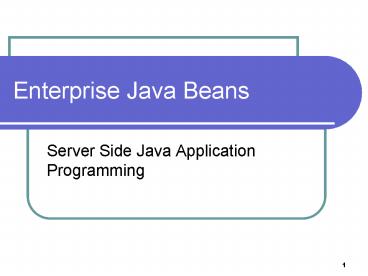Enterprise Java Beans - PowerPoint PPT Presentation
1 / 22
Title:
Enterprise Java Beans
Description:
Normally servlets and JSP's will ... Contain the business logic of the application. Session Beans ... is packaged into a jar file before deployment ... – PowerPoint PPT presentation
Number of Views:41
Avg rating:3.0/5.0
Title: Enterprise Java Beans
1
Enterprise Java Beans
- Server Side Java Application Programming
2
Overall structure
Database
Java Application
Middle Tier Server
Web Browser
File System
Mobile Phone
Legacy Application
3
J2EE Server
J2EE Server
EJB Container Stateless Session Bean Stateful
Session Bean Entity Bean
Clients
Back end services
Web Container Servlet JSP Html/ Images
4
Interacting with EJBs
- Normally servlets and JSPs will interact with
EJBs - However a client application can also directly
interact with EJBs
5
J2EE Services
- EJB container provides
- Transaction Management
- Security
- Remote Client Connectivity
- Life Cycle Management
- Database Connection Pooling
6
Enterprise Java Beans
- Contain the business logic of the application
- Session Beans
- Stateless Session Beans
- Stateful Session Beans
- Entity Beans
- Container Managed Persistence
- Bean Managed Persistence (Ejb 3 has no BMP)
7
Session vs Entity Beans
8
Session and Entity Use Example
J2EE Server
EJB Container
Database
Entity Bean
Entity Bean
Session Bean
Web Container
Web Browser
Servlet
9
Structure of a J2EE Application
J2EE Application
J2EE App DD
.ear file
Web Component
Enterpries Bean
Web Comp DD JSP file Servlet class GIF/jpeg
File HTML File
EJB DD EJB class Remote class Local class
.jar file
.war file
10
Standard Deployment Descriptors
- Enterprise Archive (ear) file
- application.xml inside the META-INF directory
- Java Archive (jar) file
- ejb-jar.xml inside the META-INF directory
- Web Archive (war) file
- web.xml inside the WEB-INF directory
11
Application Server
- Netbeans 6 uses the Glassfish V2 Application
Server - Others can be used if wanted
- To deploy a J2EE application on Glassfish V2 we
need to add several vendor deployment descriptors - sun-web.xml inside the WEB-INF directory
- sun-ejb-jar.xml inside the META-INF directory
12
Enterprise Beans
- All enterprise beans need
- Bean Class
- Implementation of the bean
- Local Interface
- Allows Clients to Connect in the same Virtual
Machine, very efficient - Remote Interface
- Allows Clients to connect using RMI/ IIOP, used
when client in different virtual machine.
13
Session Beans
- Bean Class
- Implements the business method of the bean
- Local Interface
- Defines the business methods that a local client
can call. - Remote Interface
- Defines the business methods that a remote client
can call. - NOTE the business methods are implemented in the
Bean Class
14
Session Bean Class
- Implements the SessionBean Interface
- Must define
- One or more ejbCreate methods
- ejbRemove()
- ejbActivate()
- ejbPassivate()
- setSessionContext(SessionContext sc)
- In Ejb3 implemented via _at_Stateless of
_at_Stateful annotation - Can define additional business methods
- Must Implement any Local and Remote Interfaces
15
Session Bean Class Business Methods
- Addition business methods can be defined in the
Session Bean Class - public double convertL(double dollars)
- return dollars 1.95
- public double convertR(double dollars)
- return dollars 1.95
16
Session Bean Local Interface
- Local Interface defines any business methods that
a local client may invoke - These methods signatures must match exactly those
business methods defined in the Session Bean
Class - public double convertL(double dollars)
17
Session Bean Remote Interface
- Remote Interface defines any business methods
that a remote client may invoke - These methods signatures must match exactly those
business methods defined in the Session Bean
Class - public double convertR(double dollars)
18
Packaging the Session Bean
- The Session Bean is packaged into a jar file
before deployment - The Netbeans IDE packages the bean including any
deployment descriptors - ejb-jar.xml
- sun-ejb-jar.xml
19
Accessing and using the Session Bean (from a
Servlet)
- Declare the Session Bean using the _at_EJB
annotation - _at_EJB
- private sbConvLocal sbConvBean
- Use the Session Bean in the servlet code
- sbConvBean.convL(100)
20
Stateful Session Bean Lifecycle
21
Stateless Session Bean Lifecycle
22
Summary
- Main points to remember
- J2EE Application server
- EJB container
- Entity and Session Beans
- Session Bean details
- Bean Class
- Home Interface
- Remote Interface































